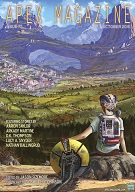“When the Fall is All That’s Left” by Arkady Martine
Reviewed by Nicky Magas
After flying through a star in Arkady Martine’s “When the Fall is All That’s Left,” Gabriele knows that she and her captain Iris are in dire shape. There’s no gravity, no telemetry and Iris is suffering every physical manifestation of gross radiation poisoning imaginable. But previously faced with the choice between death in freedom or life in bondage, the consequences of their decision are easier to bear. With Iris counting down her life in minutes and Gabriele helpless to save her or even navigate the ship she is wired to, their newly won freedom is lost in the emptiness of space. One may die and one may survive, but only if Iris can free Gabriele from the ship’s internal circuitry, and only if Gabriele still knows how to pilot the ship manually.
“When the Fall is All That’s Left” is a beautifully written story with a slowly sinking, tragic narrative. From the first line the reader gets a sense that nothing good is going to come to the characters in the story. The pacing is wonderfully measured and bits of the story seep out in a slow, casual flow, adding to the tone of despair that is prevalent throughout the story. The relationship between Gabriele and Iris unfolds only near the end, and though almost nothing is implicitly said about their history, the dialogue and the gravitas of this single scene are enough for the reader to fill in their own blanks. No tears are shed in the narrative, but the reader can see them between the lines and perhaps in their own eyes by the closing sentence.
In “Super Duper Fly” by Maurice Broaddus, an entirely separate universe of tropes sits just off the page, directing the actions and reactions of the narrative and it’s characters in subtle but familiar ways. The Council of Negro Stereotypes plays its part as well, carefully injecting themselves into stories to help the white protagonist along his or her way—a gentle, non-threatening, guiding light through their darkest hours. But for one stereotype, The Magical Negro, this bit part has gone on long enough. He’s tired of wasting his talents on the trivial problems of white heroes. Despite the protestations of the rest of the Council, The Magical Negro wants to try things his own way, for a while. Maybe carve himself his own narrative. And with all the powers he’s got at his disposal, who is there to stop him?
“Super Duper Fly” doesn’t so much break the fourth wall as completely obliterate it. Or maybe there was never a fourth wall to begin with. In each of the three parts of the story—the first white narrative, the gathering of The Council of Negro Stereotypes, and the second white narrative—the story reaches a new height of parody until it’s clear that there was never a traditional story structure there to begin with. It naturally touches on the issue of portrayal of people of color in white narratives, and gives the reader a bit of depth into the history and usage of such characters. Some tropes are so prevalent in our collective storytelling culture that we rarely question why they are there or how we use them. “Super Duper Fly” asks readers to take a closer look at some of these stereotypes and the limiting or harmful roles we sometimes impose on PoC characters.
In D. K. Thompson’s “All Things to All People,” some folks just need a little grace. It takes a different form with each person, and sometimes it takes a little bit of patience to find out what is actually needed to help, but one thing is always the same: when it’s done, there’s a new tattoo to show for it. This is a problem for the protagonist of the story. There’s only a limited amount of skin left to tattoo, and when it’s all used up, death follows shortly after. There’s no running from this job, and there are more people to save than there is skin to tattoo. Time, and skin, is running out.
Thompson writes a short, tidy little mystery in this supernatural story. The prose is simple, straight forward and without frill—we’re not even given a name for the protagonist—but the pace and the piecemeal reveal of information, even the information that is left to the reader’s own imagination, makes the story gripping from the first paragraph to the last. There’s never a moment in the story when the reader runs out of questions. At the end we’re left with only the bare minimum to be satisfied with the story, yet our curiosity remains hungry. The faceless protagonist is plaintive and determined, human and inhuman and nonetheless relatable to most readers.
Meth makes zombies, that much is common knowledge, but in Aaron Saylor’s “Me and Jasper, Down By the Meth Shack” it takes a whole different sort of monster to cook the drug. The kind of monster that would rip bloody chunks out of a young woman. The kind you can only put down with special bullets.
“Me and Jasper, Down By the Meth Shack” starts at a crawl, but the combination of voice, timing, and reveal lures readers slowly to where the action springs to life. The Kentucky setting coupled with the tense yet mundane opening leaves readers combing through every word for the surprise they know must be buried somewhere in the narrative. Between addressing the audience directly and slipping back in time to impart some crucial backstory, Saylor weaves a well-crafted horror story that manages to breathe some life into an old monster favorite.
 Apex #77, October 2015
Apex #77, October 2015